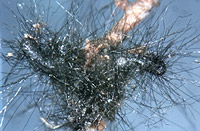
 |
– Enlarged view – |
| • references | |
| Palfner G (1994) Charakterisierung und Identifizierung einiger Ektomykorrhizen an Eiche (Quercus robur L.) in Slowenien. Dipl thesis Univ München. | |
| • ramification presence-type | |
| monopodial-pyramidal | |
| • ramification orders | |
| 0 | Lower value of unspecified range (could be µ-s.d., but not known) |
| 1 | Upper value of unspecified range (could be µ+s.d., but not known) |
| • rhizomorphs as stout, short, conical structures presence-abundance | |
| absent | |
| • rhizomorphs as short mycorrhiza-like outgrowths with blunt tips presence | |
| absent | |
| • rhizomorphs presence | |
| absent | |
| • exploration type | |
| short distance | |
| • colour | |
| black | |
| or | grey |
| • mantle cortical cells visibility | |
| not visible | |
| • mantle {distinct} surface visibility | |
| present | |
| • mantle transparency | |
| not transparent | |
| • mantle laticifers visibility | |
| present | |
| • mantle dots presence-colour | |
| absent | |
| • mantle carbonizing presence | |
| absent | |
| • mantle surface {in general} habit | |
| not smooth | |
| • mantle surface {in detail} kind | |
| densely grainy or warty | |
| or | loosely woolly |
| • presence | |
| present | |
| • abundance | |
| abundant | |
| • presence | |
| absent | |
| • organisation | |
| plectenchymatous | |
| • mantle type | |
| hyphae star-like arranged and tightly glued together (type G) | |
| • septa clamps presence | |
| absent | |
| • cell pigment location-colour | |
| membranaceously brownish | |
| • organisation | |
| plectenchymatous | |
| • organisation | |
| plectenchymatous | |
| • septa clamps presence | |
| absent | |
| • mantle different layers presence | |
| not discernable | |
| • outer mantle layer organisation | |
| pseudoparenchymatous | |
| • middle mantle layer organisation | |
| pseudoparenchymatous | |
| • inner mantle layer organisation | |
| pseudoparenchymatous | |
| • presence | |
| absent | |
| • anatomy mantle longitudinal section cortical (epidermal) cells shape | |
| radially-oval to -elliptic, oriented obliquely | |
| • mantle different layers presence | |
| not discernible | |
| • outer mantle layer organisation | |
| pseudoparenchymatous | |
| • middle mantle layer organisation | |
| pseudoparenchymatous | |
| • inner mantle layer organisation | |
| pseudoparenchymatous | |
| • anatomy mantle cross-section hyphal cells around cortical (epidermal) cells shape | |
| roundish | |
| or | beaded |
| • anatomy mantle cross-section hyphal rows around cortical (epidermal) cells number | |
| one | |
| • backwards-oriented clamps presence | |
| absent | |
| • cell pigment location-colour | |
| membranaceously brownish | |
| • clamps presence | |
| absent | |
| • clamps hole presence | |
| absent | |
| • clamps blister-like structure {at basis} presence | |
| absent | |
| • anatomy emanating elements emanating hyphae cell wall surface habit | |
| smooth | |
| or | rough of warts |
| • type | |
| lacking, only emanating hyphae present (type G) |
|
| • presence | |
| absent | |
| • geographic occurrence continent | |
| Europe | |
| • plant family | |
| Fagaceae | |
| • plant genus | |
| Quercus | |
| • plant habitat kind | |
| forests, woods | |
| • public notes | |
| Mycorrhizal ends black or grey-black; in longitudinal section mantle with some nests of smaller cells, Hartig net 1 cortical cell layer deep, in cross-section 2-3. | |